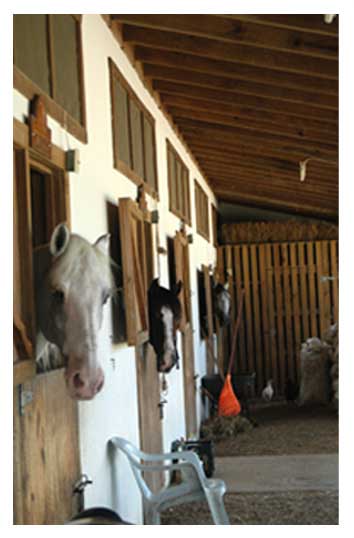Take Time To Inspect & Clean Your Tack
While some parts of the country are still in the grip of winter, other parts are just starting to show signs of spring. Either of these can cause conditions not favorable for riding. My last post suggested that you use some of this time to brush up on horse basics by doing ground work.
Another task that can be done is cleaning & conditioning your tack. Dedicate an afternoon to this task. Check your leather goods for cracks, dry rot or splits. Look at the stitching to make sure they are all intact with no breaks. You can replace leather pieces like off-billets, tie straps or some stirrup leathers that are worn out. These are easy fixes but if not replaced can cause major accidents. For more severe repairs, schedule a trip to your local saddle repair shop.
You also need to clean your bits. Run your fingers along the mouth piece to check for rough spots or burrs. Any imperfection on any of the surfaces that actually come in contact with the horse can cause irratation, pain or even cuts. Most bits are relatively inexpensive. You might consider buying a replacement.
If you are like me, this could be a daunting task in itself because of the amount of tack I have. But don’t let that stop you. Your tack is a big investment & it deserves some of your time.

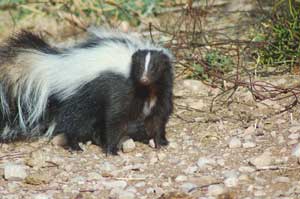 pasture. There was even a red fox that showed up but never stopped. It made its hurried travel through the pasture to get to cover in the next property. There were the urban possums & rabbits. You could catch a glimpse of an occasional owl at dusk in the fall. The one critter that seemed to make it’s home somewhere near (or under) the buildings was a skunk.
pasture. There was even a red fox that showed up but never stopped. It made its hurried travel through the pasture to get to cover in the next property. There were the urban possums & rabbits. You could catch a glimpse of an occasional owl at dusk in the fall. The one critter that seemed to make it’s home somewhere near (or under) the buildings was a skunk.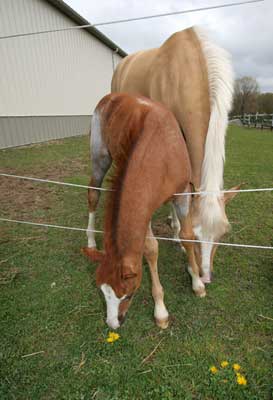 accompany each vet on calls and the barn manager who looks after your horse if he needs to stay for more intensive care. I really appreciate each & every one of these people. They do a great job. A presentation was done by each of the 2 new vets. One was on the importance of proper wound care. I could go on for days about this subject because my horses have given me plenty of practice. But I would like to talk about how you can possibly prevent some injuries.
accompany each vet on calls and the barn manager who looks after your horse if he needs to stay for more intensive care. I really appreciate each & every one of these people. They do a great job. A presentation was done by each of the 2 new vets. One was on the importance of proper wound care. I could go on for days about this subject because my horses have given me plenty of practice. But I would like to talk about how you can possibly prevent some injuries.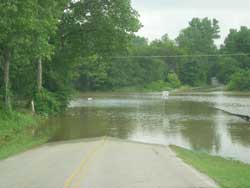 looked for hours & did not find a spot of blood or the tell tale sign of horse hair on a fence post or tree branch. Zip’s injuries were costly & required weeks of stall rest to heal.
looked for hours & did not find a spot of blood or the tell tale sign of horse hair on a fence post or tree branch. Zip’s injuries were costly & required weeks of stall rest to heal.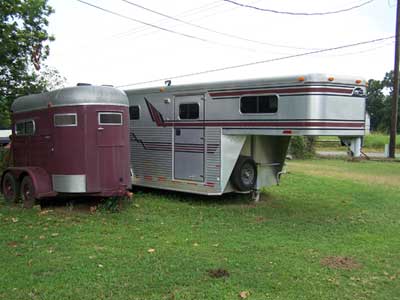 Dollar is my 6 year old palomino gelding. I named him after the horse John Wayne rode in his movies. Never mind that the movie Dollar was a sorrel, I am just one of those avid “Duke” movie fans. Anyway, Dollar is just about as laid back as a horse can get. I haven’t found anything that bothers him. He also has as much curiosity as any cat. He’s always looking to see what you are doing and at times it seems like he would really rather help you with whatever it is you’re doing. He’ll walk along side of the tractor while the pasture is being mowed looking like he’s trying to tell you how to drive & mow. He stands guard by a ladder while you are on the roof. He also likes to floss his teeth with the tail of the lead rope you have him tied with.
Dollar is my 6 year old palomino gelding. I named him after the horse John Wayne rode in his movies. Never mind that the movie Dollar was a sorrel, I am just one of those avid “Duke” movie fans. Anyway, Dollar is just about as laid back as a horse can get. I haven’t found anything that bothers him. He also has as much curiosity as any cat. He’s always looking to see what you are doing and at times it seems like he would really rather help you with whatever it is you’re doing. He’ll walk along side of the tractor while the pasture is being mowed looking like he’s trying to tell you how to drive & mow. He stands guard by a ladder while you are on the roof. He also likes to floss his teeth with the tail of the lead rope you have him tied with.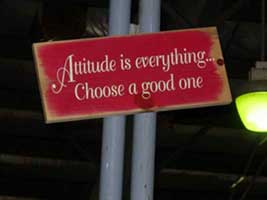
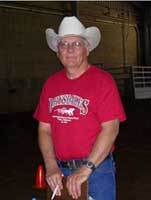 The Palomino World Show finished up it’s week long run. As always, it was a very good show. This is about my 20th year to volunteer for this show. When I started volunteering for this show, I didn’t even own a palomino. I didn’t purchase my first palomino until 2002. I volunteer for this show because I absolutely love doing it. I take a week vacation from my job to volunteer. I get to see some old friends that I have made over the years and I always meet new ones.
The Palomino World Show finished up it’s week long run. As always, it was a very good show. This is about my 20th year to volunteer for this show. When I started volunteering for this show, I didn’t even own a palomino. I didn’t purchase my first palomino until 2002. I volunteer for this show because I absolutely love doing it. I take a week vacation from my job to volunteer. I get to see some old friends that I have made over the years and I always meet new ones. 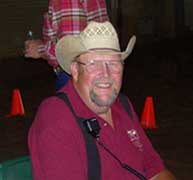 The show then was only 3 very long days. I learned to read fast and on the run. The show has grown over the past 20 years to the 7 day show it is today. I still have to speed read and do it on the run. Some things never change.
The show then was only 3 very long days. I learned to read fast and on the run. The show has grown over the past 20 years to the 7 day show it is today. I still have to speed read and do it on the run. Some things never change. 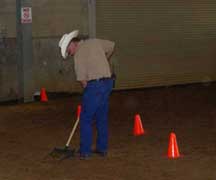 If you DO decide to volunteer, some things to remember are to always be pleasant & courteous to both exhibitors and staff. You may be a volunteer, but you are one of the many faces for the organization putting on the show. Help out for any job that is needed. If you are not sure of the duties, ask one of the staff members for some guidance before the show starts. If there is a problem, ask one of the staff members of the organization to help. Don’t take longer for meals than any other staff member. Don’t be in the wrong place or take a job that was not assigned to you. Be prepared by bringing your own pen, water bottle and possibly small snacks. There may not always be time to run to the water fountain. Unless you are instructed to wear specific clothes, dress comfortably. Don’t wear boots that pinch your toes or sandals. You are probably going to be on your feet and on the move all day long. At the end of the show, turn in any equipment that you were given. Also before you leave the show, make sure you check in with a staff member. They will appreciate knowing that you are no longer on duty.
If you DO decide to volunteer, some things to remember are to always be pleasant & courteous to both exhibitors and staff. You may be a volunteer, but you are one of the many faces for the organization putting on the show. Help out for any job that is needed. If you are not sure of the duties, ask one of the staff members for some guidance before the show starts. If there is a problem, ask one of the staff members of the organization to help. Don’t take longer for meals than any other staff member. Don’t be in the wrong place or take a job that was not assigned to you. Be prepared by bringing your own pen, water bottle and possibly small snacks. There may not always be time to run to the water fountain. Unless you are instructed to wear specific clothes, dress comfortably. Don’t wear boots that pinch your toes or sandals. You are probably going to be on your feet and on the move all day long. At the end of the show, turn in any equipment that you were given. Also before you leave the show, make sure you check in with a staff member. They will appreciate knowing that you are no longer on duty.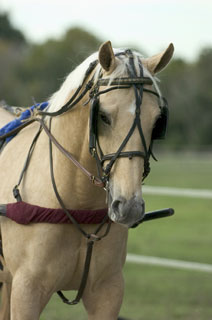 The Palomino Youth World Show is now in full swing. If you live in the Tulsa Oklahoma area, THIS IS A MUST SEE!!!! No where else can you see so many beautiful golden horses in one place. No where else can you see so many different variations of the golden horse. Whether you like trail, English, Western or Halter, there is a class that will catch your attention. Come out to the Tulsa fairgrounds and see the kids guide these horses around the arena and put them through their paces. Go to
The Palomino Youth World Show is now in full swing. If you live in the Tulsa Oklahoma area, THIS IS A MUST SEE!!!! No where else can you see so many beautiful golden horses in one place. No where else can you see so many different variations of the golden horse. Whether you like trail, English, Western or Halter, there is a class that will catch your attention. Come out to the Tulsa fairgrounds and see the kids guide these horses around the arena and put them through their paces. Go to 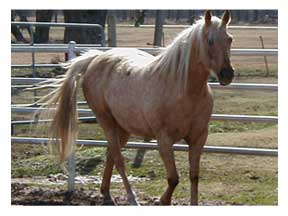 The floundering economy has touched the horse industry in so many ways. My own personal concession is I had to sell one of my horses. I did this last November (before Iggette passed) to try to cut the rising cost of my board bill as well as the vet bill. I didn’t want to sell Princess (pictured) and it was a hard decsison to make. Actually I was supposed to sell one when I purchased my gelding over 2 years ago. I just didn’t ever get around to it. Quite honestly if we lived on our acreage instead of in town, I wouldn’t have sold her. But she has a very nice owner who decided to stay at the barn where I am, so I get to see her all the time. After Iggette passed away, I was left with 2 horses. Even with my board bill being reduced by 2 horses, the money crunch can still be felt. I have made some small adjustments in my horse keeping to save some money. Here are a few of the ways that I chosen to save money. Please keep in mind that my choices may not work for you. Make your decisions wisely.
The floundering economy has touched the horse industry in so many ways. My own personal concession is I had to sell one of my horses. I did this last November (before Iggette passed) to try to cut the rising cost of my board bill as well as the vet bill. I didn’t want to sell Princess (pictured) and it was a hard decsison to make. Actually I was supposed to sell one when I purchased my gelding over 2 years ago. I just didn’t ever get around to it. Quite honestly if we lived on our acreage instead of in town, I wouldn’t have sold her. But she has a very nice owner who decided to stay at the barn where I am, so I get to see her all the time. After Iggette passed away, I was left with 2 horses. Even with my board bill being reduced by 2 horses, the money crunch can still be felt. I have made some small adjustments in my horse keeping to save some money. Here are a few of the ways that I chosen to save money. Please keep in mind that my choices may not work for you. Make your decisions wisely.